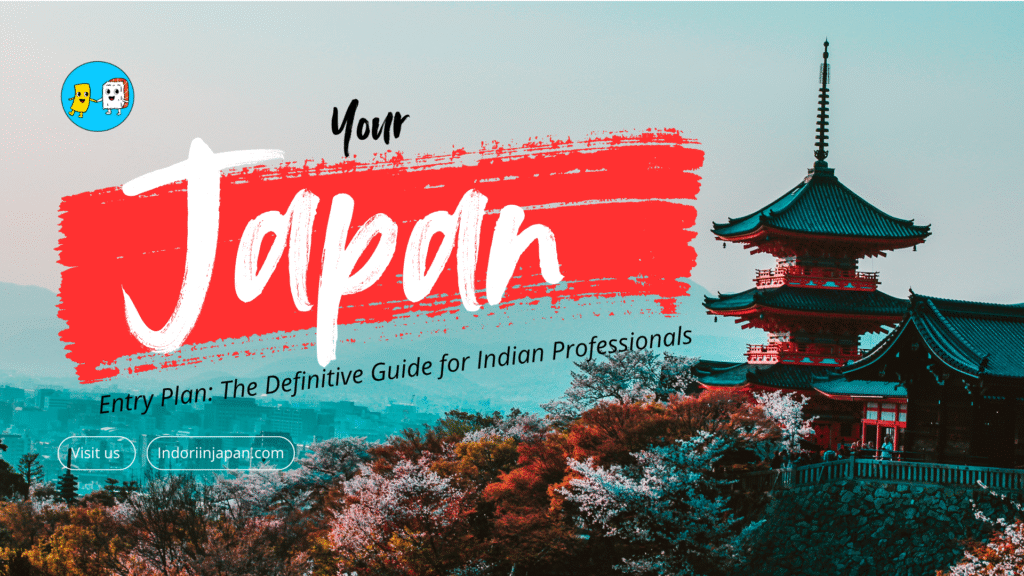Introduction (How to Move to Japan-India: The Ultimate Guide for Indian)
Japan, a nation synonymous with technological innovation, cultural richness, and economic prowess, is increasingly becoming a prime destination for skilled Indian professionals. As the country actively seeks to attract global talent to fuel its advanced industries in IT, engineering, finance, and research, the opportunities for Indian experts are more significant than ever. However, the path to relocating is a structured journey that requires careful planning, particularly concerning the two foundational pillars of any move: securing the appropriate work visa and finding suitable housing. The processes, while methodical, can appear complex from the outside, involving procedures in both India and Japan.
This guide serves as a comprehensive, step-by-step roadmap tailored specifically for Indian professionals and individuals. It demystifies the Japanese immigration and housing systems, translating intricate requirements into actionable advice. From navigating the crucial Certificate of Eligibility and selecting the right visa pathway to understanding the unique rental market and managing initial finances, this report addresses the specific questions and concerns of an Indian applicant, providing the clarity and confidence needed to embark on a successful professional journey in Japan.
1: Securing Your Work Visa—A Guide for Indian Professionals
The process of obtaining a Japanese work visa from India is a two-stage, two-country operation. The most substantive part of the application—the verification of your eligibility and your employer’s legitimacy—occurs in Japan. The final visa issuance in India is largely a procedural confirmation once this primary hurdle is cleared. Understanding this sequence is fundamental to a smooth application experience.
1.1 The Cornerstone of Your Application: The Certificate of Eligibility (CoE)
The single most important document in the Japanese work visa process is the Certificate of Eligibility, or CoE. This is not a visa itself but rather an official document issued by a regional immigration authority under the jurisdiction of the Immigration Services Agency of Japan. It certifies that the foreign national conforms to the conditions for landing in Japan, meaning the activities they intend to engage in (i.e., their proposed job) are legitimate and permissible under a specific status of residence.
The critical point for any Indian applicant to understand is that the CoE application is not filed by the individual in India. Instead, it is applied for and obtained by a proxy in Japan, which is almost always the sponsoring company or employer. This structure creates a clear and non-negotiable dependency on the Japanese employer, making the first practical step for any prospective applicant not visa paperwork, but securing a job offer from a company that is willing and able to sponsor the CoE.
The process flow is as follows:
- Secure a Job Offer: The applicant receives a formal job offer from a company based in Japan.
- Employer Applies for CoE: The Japanese company gathers the necessary documents from the applicant (such as CV, degree certificates, and passport copy) and submits a CoE application on their behalf to the regional immigration bureau in Japan.
- CoE is Issued and Mailed: Once the Immigration Services Agency approves the application, it issues the CoE. The employer then mails the original document to the applicant in India.
- Visa Application in India: With the original CoE in hand, the applicant can then proceed with the final visa application at a designated VFS Global center in India. Presenting a CoE significantly streamlines this final stage, as it proves that the substantive screening has already been completed in Japan.
1.2 Choosing Your Pathway: An Analysis of Key Work Visas for Indians
Japan offers several categories of work visas, each designed for different professionals. Profiles. For Indian professionals, three main pathways are most relevant: the prestigious Highly Skilled Professional (HSP) visa, the common Engineer/Specialist visa, and the industry-specific Specified Skilled Worker (SSW) visa.
The Highly Skilled Professional (HSP) Visa
The HSP visa is a strategic immigration category introduced by the Japanese government to attract and retain top-tier global talent who can contribute to the nation’s economic and technological advancement. It operates on a points-based system where applicants are evaluated based on their academic background, professional experience, annual salary, and age. Bonus points are also awarded for qualifications such as Japanese language proficiency (as demonstrated by JLPT certification), holding a patent, or having graduated from a top-ranked university. An applicant must score a minimum of 70 points to qualify.
The benefits of the HSP visa are substantial and extend far beyond simple employment permission, positioning it as an integrated family relocation and long-term settlement package. This signals a clear policy objective from the Japanese government: to encourage high-value professionals not just to work in Japan but to put down roots, bring their families, and integrate into society for the long term.
Key benefits include:
- Accelerated Path to Permanent Residency (PR): This is the most significant advantage. HSP visa holders who maintain a score of 70 points or more can apply for PR after just three years of residence. Those with 80 points or more can apply in as little as one year, a dramatic reduction from the standard 10-year requirement.
- Spousal Employment: The spouse of an HSP visa holder is permitted to work full-time without being subject to the usual educational or professional experience requirements that apply to other work visas.
- Sponsorship of Parents: Under specific conditions (e.g., to care for a grandchild under the age of seven), HSP visa holders can sponsor their parents to live with them in Japan.
- Preferential Processing: Immigration procedures for HSP visa holders are often processed more quickly.
For any highly qualified Indian professional with a long-term vision for their career and family in Japan, securing the HSP visa should be the primary objective.
Engineer/Specialist in Humanities/International Services Visa
This is the most common category of work visa issued to foreign professionals and is the typical route for Indian IT engineers, software developers, financial analysts, marketing specialists, interpreters, and foreign language teachers.
The primary eligibility criteria are straightforward and designed to verify professional competence. An applicant generally needs to demonstrate one of the following:
- A relevant bachelor’s degree from an accredited university.
- At least 10 years of documented professional experience in the relevant field.
This visa is sponsored by the employing company and is tied to the specific type of work outlined in the application. The period of stay granted can be 3 months, 1 year, 3 years, or 5 years, and it is renewable.
Specified Skilled Worker (SSW) Visa
The SSW visa was established to address severe labour shortages in specific industrial fields in Japan. It is aimed at foreign nationals who possess a certain level of expertise and skill, allowing them to work immediately without extensive training. For Indian nationals, this pathway requires passing both a skills proficiency test and a basic Japanese language test for the relevant industry.
The SSW system is divided into two categories:
- SSW (i): This allows for a stay of up to five years in total across 14 specified fields, including nursing care, building cleaning, construction, and the food service industry. Importantly, holders of this visa are generally not permitted to bring their families to Japan.
- SSW (ii): This is a more advanced category for those with proficient skills, currently available in fields like construction and shipbuilding. It allows for indefinite renewals, effectively opening a path to long-term residency, and permits the holder to sponsor their spouse and children to live in Japan.
| Visa Type | Target Professionals | Key Eligibility | Period of Stay | Path to Permanent Residency | Family Sponsorship |
|---|---|---|---|---|---|
| Highly Skilled Professional (HSP) | Top-tier professionals in research, tech & business management | Points-based system (70+ points) based on salary, experience, education, etc. | 5 years | Accelerated: 1-3 years | Spouse (full work rights), children, and parents (under certain conditions). |
| Engineer/Specialist in Humanities/International Services | IT professionals, engineers, financial analysts, marketers, and teachers. | Relevant bachelor's degree or 10+ years of experience. | 3 months, 1, 3, or 5 years (renewable) | Standard: 10 years | Spouse and children (dependents, limited work rights for spouse). |
| Specified Skilled Worker (SSW) | Workers in specific industries with labour shortages (e.g., nursing, construction). | Pass skill and Japanese language proficiency tests. | (i) Up to 5 years total. (ii) Renewable indefinitely. | (i) No direct path. (ii) Possible after long-term residence. | (i) Not permitted. (ii) Spouse and children permitted. |
1.3 The Application Process in India: A Step-by-Step Walkthrough
Once the CoE has been received from the Japanese employer, the final step is to apply for the visa itself in India. This process is facilitated by VFS Global, the official partner of the Embassy of Japan in India. Applications must be submitted at a designated VFS Japan Visa Application Centre.
The procedure is as follows:
- Receive the Original CoE: Ensure the original Certificate of Eligibility has arrived safely from Japan.
- Gather Documents: Assemble all required documents as per the official checklist. Incomplete applications can lead to delays or cancellation, requiring a re-application.
- Complete the Application Form: The visa application form can be downloaded from the VFS Global or the Embassy of Japan in India website. It must be filled out completely and accurately.
- Submit at VFS Centre: Visit the appropriate VFS centre based on jurisdiction. For most long-term visa categories with a CoE, a prior appointment is not required; applicants can simply walk in.
- Pay Fees: The visa fee and the VFS service charge must be paid at the time of submission. Payment is typically made in Indian Rupees (INR).
- Track Application: After submission, the application status can be tracked online via the VFS Global portal. Once processed, the applicant will be notified to collect their passport from the VFS centre.
- Valid Indian Passport: Must be valid for the intended stay and have at least two blank pages.
- Old Passports:. All previous passports must be submitted, if any.
- Visa Application Form: Completed and signed.
- Photograph: One recent passport-size photograph (2x2 inches, colour, white background) pasted on the form.
- Original Certificate of Eligibility (CoE): The original document received from Japan.
- Employment Contract / Offer Letter: A copy of the contract detailing position, salary, and duration.
- Curriculum Vitae (CV): An updated resume.
- Academic & Professional Credentials: Copies of degree certificates, diplomas, and relevant professional qualifications.
- Income Tax Returns (ITRs): Acknowledgements for the last 2-3 financial years.
- Bank Statements: Stamped and signed personal bank statements for the last 3-6 months to demonstrate financial stability.
1.4 Budgeting for Your Visa: Fees and Timelines
One of the positive aspects of the Japanese visa process for Indian nationals is the relatively low cost. As of the 2025-2026 fiscal year, the visa fee for Indian citizens for a single- or multiple-entry visa is only ₹450. A separate service charge will be collected by VFS Global.
The standard processing time is approximately five working days from the date of submission at the embassy. However, it is crucial to be aware that this timeline is not guaranteed. The Embassy has noted that due to high volumes of applications, processing times can vary significantly and may take longer. Visa processing cannot be expedited based on an applicant’s travel schedule. Therefore, it is highly recommended to apply well in advance. Applications can be submitted up to three months before the intended date of travel.
2: Navigating the Japanese Housing Market—An Indian Perspective
For many Indian professionals, the Japanese rental market presents the steepest learning curve and the most significant financial outlay upon arrival. The system is characterised by unique customs, high initial costs, and procedural hurdles that are vastly different from the rental process in India. Strategic planning and understanding these differences are key to securing a home without undue stress or financial strain.
2.1 Decoding the Rental System: Initial Costs and Key Terminology
The most immediate shock for newcomers is the scale of upfront costs. While renting in India typically requires a security deposit of 2-3 months’ rent, the initial move-in cost for a Japanese apartment can easily amount to 4 to 7 times the monthly rent. This substantial capital requirement must be budgeted for before arrival.
These costs are composed of several distinct fees, each with a specific name and purpose:
- Shikikin (敷金) – Security Deposit: This is equivalent to 1-2 months’ rent and is the most familiar fee for Indian renters. It is a refundable deposit held by the landlord to cover potential damages to the property or unpaid rent. After moving out, the cost of standard cleaning and any necessary repairs beyond normal wear and tear will be deducted, and the remainder will be returned.
- Reikin (礼金) – Key Money: This is a non-refundable payment, typically 1-2 months’ rent, given to the landlord as a “gift” or a gesture of gratitude for allowing the tenant to rent their property. This custom, which can be perplexing to foreigners, has its roots in the post-World War II era when housing was scarce. While its prevalence is slowly declining, it remains a common feature, especially in high-demand areas.
- Chukai-tesuryo (仲介手数料) – Agent’s Commission: This is the fee paid to the real estate agency for their services in finding the apartment and facilitating the contract. By law, this fee is capped at one month’s rent plus consumption tax.
- Hoshogaisha-hiyo (保証会社費用) – Guarantor Company Fee: As most foreigners cannot provide a personal guarantor, they must use a guarantor company. This fee, paid to the company for their service, is typically 50% to 100% of one month’s rent for the first year, with an annual renewal fee thereafter.
- Other Fees: Additional smaller fees often include a lock exchange fee (kagi kokan dai, around ¥20,000) and mandatory fire insurance (kasai hoken, around ¥20,000 for a two-year policy).
2.2 The Guarantor Requirement: Overcoming a Major Hurdle
Nearly every landlord in Japan requires a tenant to have a guarantor (hoshounin), a person (historically a Japanese national with a stable income) who is legally and financially responsible for the rent and any damages if the tenant defaults. For a newly arrived Indian professional with no local family or deep-rooted connections, this requirement is practically impossible to meet personally.
Fortunately, the market has evolved to address this. The standard solution is to use a professional guarantor company (hoshōgaisha). These companies conduct their financial screening of the applicant and, for a fee, assume the role of the guarantor, providing the landlord with the necessary security. While this adds another layer of cost, it transforms what was once a social barrier into a predictable financial transaction that can be planned for.
For Indian professionals, it is advisable to work with real estate agents who partner with foreign-friendly guarantor companies. Some companies are specifically designed to serve the non-Japanese community, offering multilingual support and streamlined screening processes.
- GTN (Global Trust Networks): Widely regarded as the most foreigner-friendly option, GTN specialises in providing guarantor services for non-Japanese tenants and offers support in multiple languages, including English. Their high approval rate makes them a top choice for first-time renters.
- Other Options: Companies like Nihon Safety, Casa, and Japan Housing Trust also offer services to foreigners, though some may have stricter screening criteria or primarily Japanese-language support.
2.3 Your Best Housing Options: A Strategic Comparison
Given the complexities and costs, choosing the right type of housing, especially upon first arrival, is a critical strategic decision.
The “Hack”—UR Housing (Urban Renaissance Agency)
For those looking to bypass the most significant financial hurdles of the private rental market, UR Housing is an outstanding option. These are public housing units managed by the Urban Renaissance Agency, a government-affiliated body. Their primary advantage lies in what they
don’t require, summarised as the “Four No’s”:
- No Key Money (Reikin)
- No Agent Commission (Chukai-tesuryo)
- No Guarantor Required
- No Lease Renewal Fees
This model drastically reduces initial move-in costs, making it an incredibly attractive choice for foreigners. The requirements for Indian nationals are also more straightforward than for private rentals, typically involving a valid Residence Card, a Residence Certificate (juminhyo), and proof of sufficient income (e.g., a tax certificate or employment letter).
Private Apartments (Apāto & Mansion)
This is the most common form of housing, offering the greatest variety in location, size, and quality. It’s important to understand the distinction between the two common terms:
- Apāto (アパート): Typically refers to smaller, two-story buildings with a wooden or lightweight steel frame. They are generally older and more affordable.
- Mansion (マンション): Refers to modern condominium-style buildings constructed from reinforced concrete or steel-reinforced concrete. They offer better soundproofing, insulation, and security features, and command higher rents.
While offering the most choice, this option also comes with the highest initial costs and the full set of requirements, including a guarantor company.
Share Houses & Guest Houses
For the initial period after arriving in Japan, share houses (or “gaijin houses”) are an excellent and highly recommended strategy. They offer furnished private rooms with shared communal spaces like kitchens and lounges. Their key benefits for a newcomer are:
- Low Initial Costs: They typically require only a small deposit and the first month’s rent, with no key money or agent fees.
- Flexibility: Contracts are often shorter and more flexible than the standard two-year lease for private apartments.
- Convenience: Rooms are furnished, and utilities are often included in the rent, eliminating the hassle of setting up accounts.
- Community: They provide an instant social network, which can be invaluable for combating isolation and getting practical advice when settling in.
A sound strategy for many Indian professionals is to book a room in a shared house for the first 1-3 months. This provides a stable and low-stress base from which to conduct a more thorough search for a long-term UR or private apartment once they have their Residence Card and have become more familiar with the city.
| Housing Options in Japan | Best For | Initial Cost | Guarantor Needed? | Pros | Cons |
|---|---|---|---|---|---|
| UR Housing | Long-term, cost-conscious renters (singles & families). | Low (approx. 2-3x rent) | No | No key money, agent fee, or guarantor; high quality. | Limited availability; income requirements must be met. |
| Private Apartment | Long-term renters seeking maximum choice and privacy. | Very High (4-7x rent) | Yes (Guarantor Company) | Widest choice of location, size, and amenities. | Extremely high initial costs; complex contract process. |
| Share House | New arrivals (first 1-3 months); short-term stays. | Very Low (1-2x rent) | No | Low cost, furnished, utilities included, instant community. | Less privacy, shared facilities, and can be noisy. |
2.4 Cost of Living Reality Check: Japan vs. Major Indian Cities
To make an informed financial decision, Indian professionals need to compare the cost of living in Japan with what they are accustomed to in major Indian metropolitan areas. While salaries in Japan are generally higher, the day-to-day and monthly expenses, particularly rent, can also be substantially greater. The following table provides a comparative analysis of key monthly expenses for a single professional living in a 1BHK apartment. All figures are estimates for 2025 and are provided in both Japanese Yen (JPY) and Indian Rupees (INR) for direct comparison (approximate conversion: ¥1 = ₹0.60).
| Expense Item | Tokyo | Mumbai | Delhi | Bangalore |
|---|---|---|---|---|
| 1BHK Rent (Central) | ¥100,000 - ¥160,000 (₹60,000 - ₹96,000) | ₹40,000 - ¥70,000 | ₹25,000 - ₹45,000 | ₹20,000 - ₹35,000 |
| 1BHK Rent (Suburban) | ¥70,000 - ¥100,000 (₹42,000 - ₹60,000) | ₹15,000 - ₹30,000 | ₹12,000 - ₹20,000 | ₹10,000 - ₹20,000 |
| Utilities (Basic) | ¥10,000 - ¥15,000 (₹6,000 - ₹9,000) | ₹3,000 - ₹5,000 | ₹3,000 - ₹5,000 | ₹2,500 - ₹4,000 |
| Monthly Transport Pass | ¥8,000 - ¥12,000 (₹4,800 - ₹7,200) | ₹1,000 - ₹1,500 | ₹1,000 - ₹2,000 | ₹1,500 - ₹3,000 |
| Groceries | ¥35,000 - ¥50,000 (₹21,000 - ₹30,000) | ₹5,000 - ₹8,000 | ₹4,000 - ₹7,000 | ₹4,000 - ₹8,000 |
| Meal (Mid-range Restaurant) | ¥3,000 - ¥5,000 (₹1,800 - ₹3,000) | ₹1,500 - ₹2,500 | ₹1,200 - ₹2,000 | ₹1,200 - ₹2,500 |
This data-rich comparison moves beyond generic statements to provide specific, comparable figures, allowing an Indian professional to accurately assess the financial implications of their move and negotiate their salary with a clear understanding of the local cost base.
3: Your First Month in Japan - Essential Steps for Settling In
The period immediately following arrival is critical for establishing the foundations of a stable and successful life in Japan. The focus should be on achieving financial independence by setting up banking and managing funds, and on building a social and professional support network.
3.1 Financial Foundations: Banking and Money Transfers
A significant logistical challenge for new arrivals is the “cash flow gap.” The substantial initial housing costs must be paid shortly after arrival, yet a local bank account—necessary for receiving a salary and making large payments—can only be opened after landing in Japan. Furthermore, the first salary payment may not arrive until a month after starting work. This necessitates careful pre-departure financial planning to ensure sufficient funds are accessible for the first 4-6 weeks.
Opening a Japanese Bank Account
It is not possible to open a Japanese bank account from overseas. The primary requirement is the Residence Card (zairyū kādo), which is issued to mid- to long-term residents upon arrival at major Japanese airports like Narita or Haneda.
The typical documents required to open an account are:
- Residence Card (Zairyū Kādo): This is the most essential document.
- Passport: For identity verification.
- Japanese Address and Phone Number: A local mobile number and residential address are required.
- Personal Seal (Hanko or Inkan): While some banks are becoming more accepting of signatures for foreigners, the hanko remains a traditional and often required tool for authorising official documents. These personal seals, bearing the holder’s name, can be easily and inexpensively made at shops across Japan.
For a smoother experience, Indian professionals should prioritise banks known for their foreigner-friendly services:
- Japan Post Bank (Yūcho Ginkō): With branches in post offices nationwide, it is highly accessible and known for having a relatively straightforward account opening process for foreigners.
- Shinsei Bank: Often recommended for its English-language online banking and telephone support.
- SMBC Trust Bank (PRESTIA): Caters specifically to the international community with comprehensive English-language services.
Transferring Funds from India to Japan
Moving the necessary funds from an Indian bank account to Japan to cover initial expenses requires navigating Indian regulations.
- Regulatory Framework: All outward remittances from India are governed by the Reserve Bank of India’s (RBI) Liberalised Remittance Scheme (LRS). This scheme allows resident individuals to remit up to a certain limit per financial year (currently USD 250,000) for permissible transactions, including maintenance for persons residing abroad.
- Tax Implications: A crucial consideration for Indian nationals is the Tax Collected at Source (TCS). As per current regulations, a TCS of 5% is applicable on foreign remittances exceeding ₹7 lakh in a financial year. This tax must be factored into financial planning.
- Transfer Methods:
- Bank Wire Transfers: Major Indian banks like HDFC Bank and ICICI Bank facilitate international wire transfers through their branches and online banking platforms. This requires beneficiary details such as the Japanese bank’s name, SWIFT code, and account number.
- Fintech Services: Modern platforms like Wise and Remitforex often offer more competitive exchange rates and lower fees than traditional banks. They provide a transparent and efficient way to transfer funds online.
3.2 Building Your Network: Connecting with the Indian Community
Relocating to a new country involves more than just logistical and financial planning; it is also a social and cultural transition. Fortunately, Japan is home to a large, vibrant, and well-established Indian diaspora, offering an invaluable support system for newcomers. Connecting with these communities can provide practical advice, professional networking opportunities, and a sense of belonging.
The sheer number and diversity of Indian associations in Japan are a testament to the strength of this community. These organisations offer a “home away from home” and are a powerful resource for anyone looking to build a life in the country.
Key organisations and cultural hubs include:
- All Japan Association of Indians (AJAI): A comprehensive support organisation that provides information and assistance on a wide range of topics, including visas, housing, legal matters, and professional life.
- Indian Professionals in Japan (IPJ): A networking group specifically for Indian professionals working in Japan, offering a platform for career-related connections and knowledge sharing.
- Regional and Cultural Associations: Numerous groups cater to specific linguistic and regional backgrounds, such as the Tokyo Tamil Sangam, Tokyo Marathi Mandal, Bengali Association of Tokyo, and Japan Telugu Samakhya. These organisations host cultural events, celebrate festivals, and help preserve cultural ties.
- Vivekananda Cultural Centre (VCC): Located at the Embassy of India in Tokyo, the VCC is a central hub for Indian culture. It regularly organises cultural programs, workshops, film screenings, and classes in yoga, Hindi, and classical Indian dance and music, providing a wonderful venue for cultural engagement and meeting fellow community member.
🎯 Final Take: Tokyo Isn’t Your Only Option
The journey for an Indian professional to live and work in Japan is a well-defined process that, with diligent preparation, is entirely manageable. Success hinges on a clear understanding of the key sequential steps and a proactive approach to planning. The critical path involves first securing a job offer from a Japanese employer willing to sponsor the essential Certificate of Eligibility. With the CoE in hand, the subsequent visa application in India becomes a streamlined formality.
The most significant challenge for most is financial: budgeting for the uniquely high initial housing costs is paramount. Strategic choices, such as utilising the cost-effective UR Housing system or opting for a shared house upon initial arrival, can mitigate this financial burden significantly. Furthermore, anticipating the “cash flow gap” during the first month—the period between paying these initial costs and receiving the first salary—is crucial for a stress-free transition.
Finally, the presence of a robust and diverse Indian community in Japan provides an invaluable support network that should not be underestimated. Tapping into these organisations can ease the cultural transition and accelerate the process of building a fulfilling personal and professional life. By following this structured plan, Indian professionals can confidently navigate the entry process and unlock the immense opportunities that await them in Japan.
✍️ Bonus: Need Help Starting?
✅ Job hunting tips and real listings for foreigners in Japan
✅ Visa guidance made simple—no confusing search
✅ Resume & cover letter templates (Japanese & English formats)
✅ Life in Japan explained — from rent to ramen
✅ Travel guides & city recommendations for every kind of explorer
✅ Work culture insights to help you adjust and thrive






2 thoughts on “How to Move to Japan from India: The Ultimate Guide for Professionals”
great work sir. 👏👍🫡😃
Nice bhaiya,i also yash